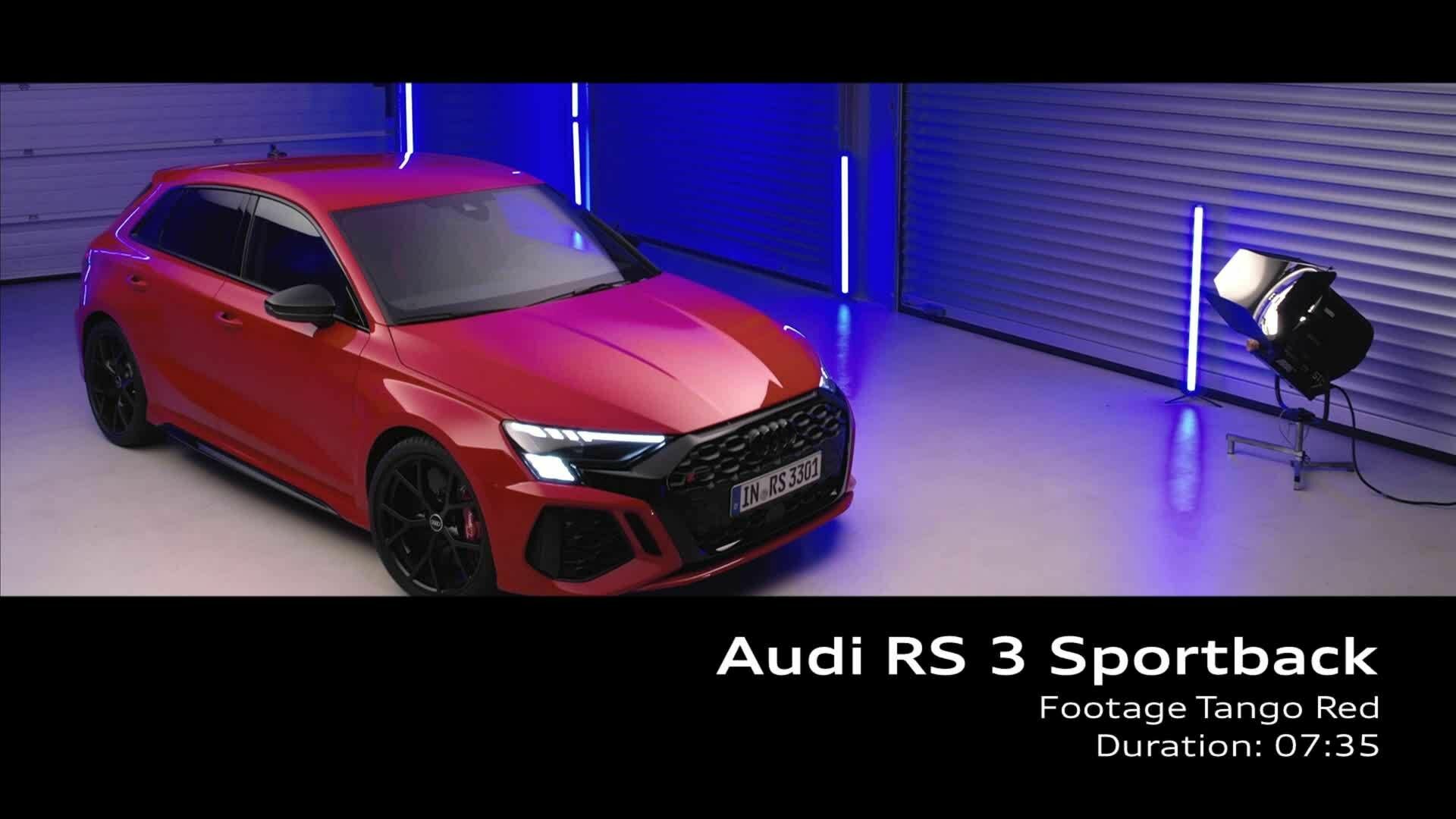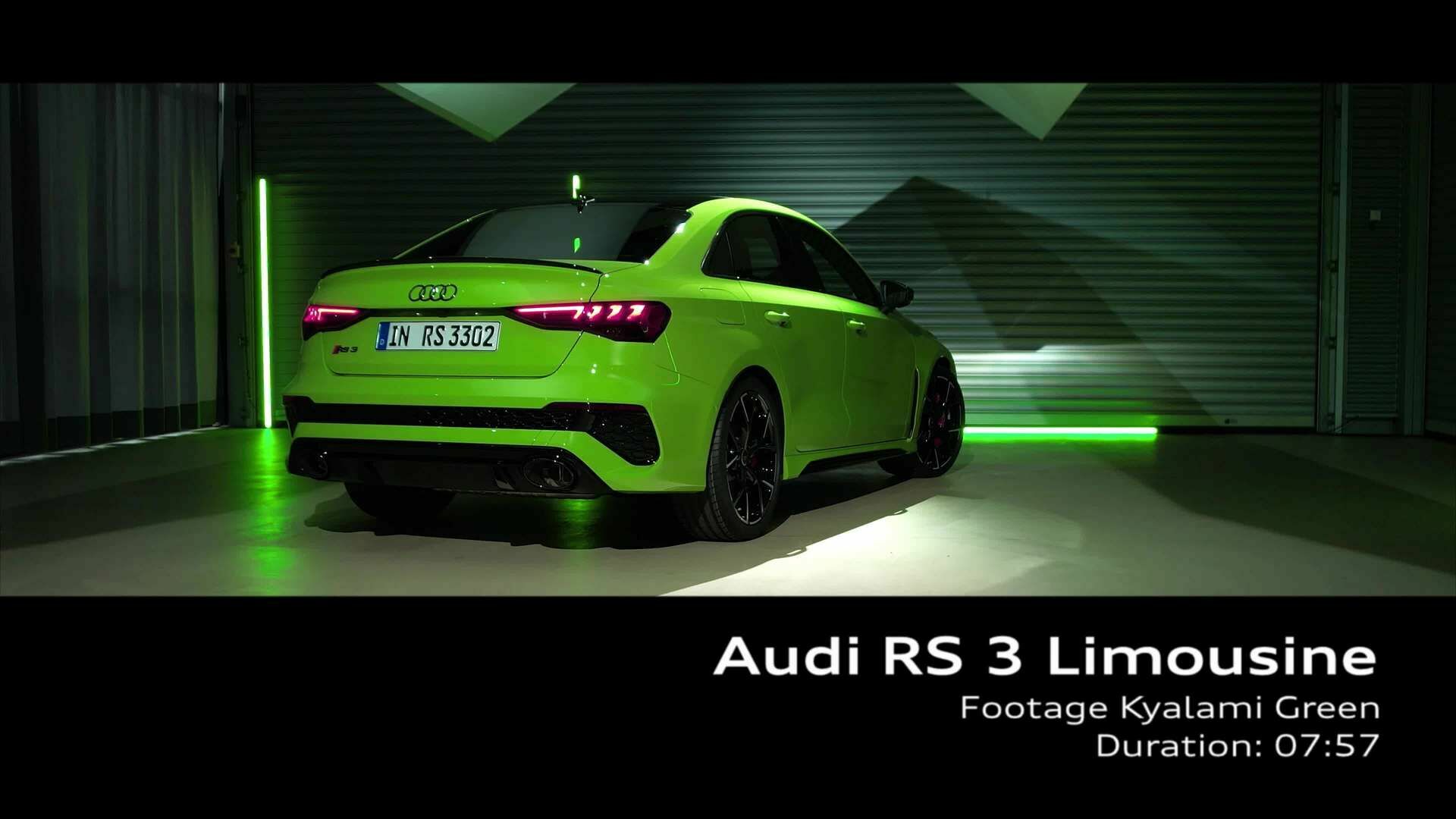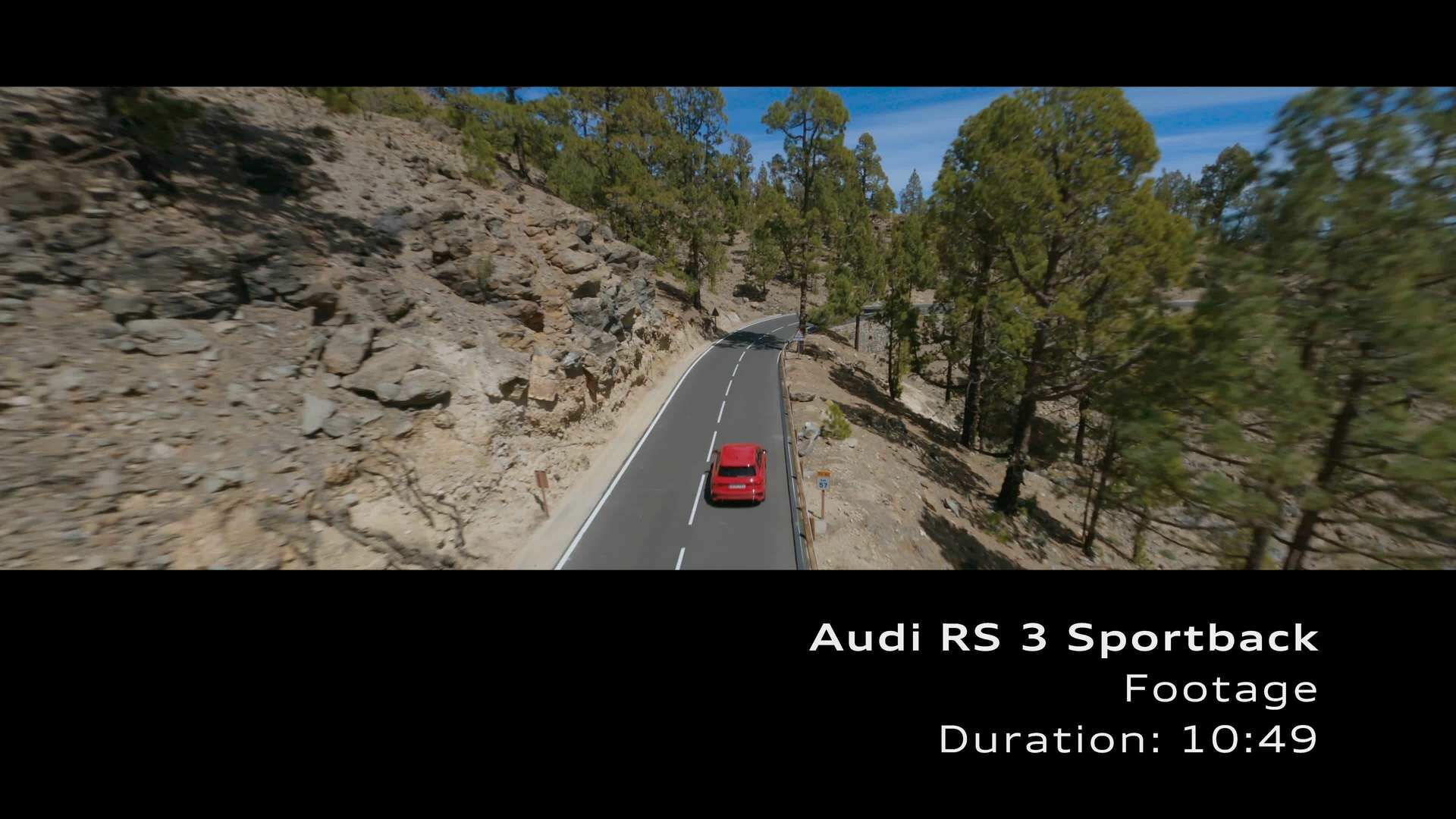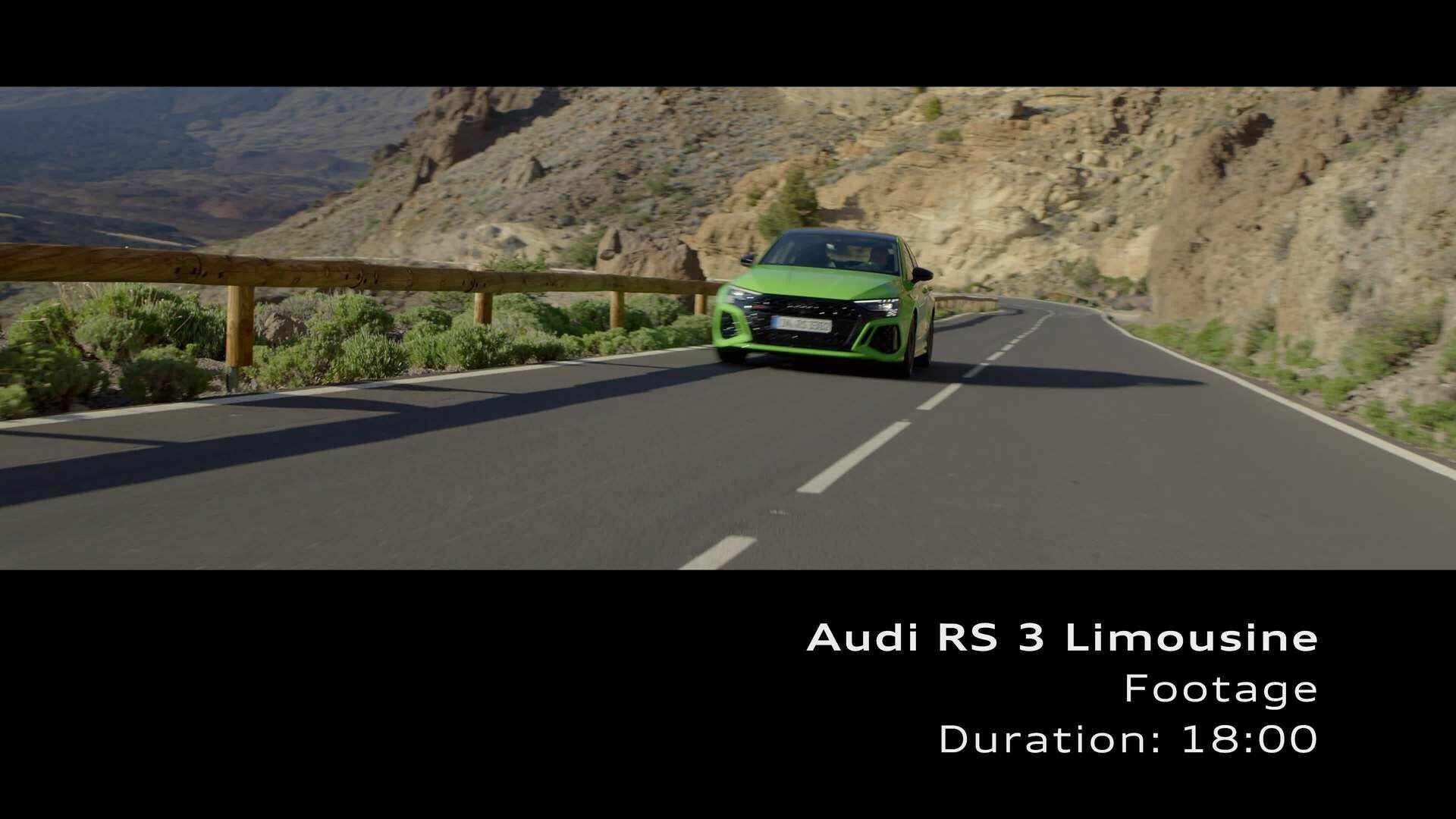The new Audi RS 3: unmatched sportiness suitable for everyday use
- 400 PS, five-cylinder engine with 500 newton meters of torque
- RS Torque Splitter and new RS 3 driving modes for even more agility
- Expressive exterior design and interior racing atmosphere

From 0 to 100 km/h in 3.8 seconds, up to 290 km/h top speed, RS Torque Splitter, semi slicks, and specific RS driving modes – the new Audi RS 3 offers driving dynamics of the highest caliber and the best numbers in its segment. Equipped with a 294 kW (400 PS) five-cylinder, the high-performance engine delivers rapid acceleration with a highly intoxicating sound. The power unit now delivers 500 Nm of torque and responds even faster. Visually, the RS 3 demonstrates its sporty DNA with a widened body, RS sports exhaust system, and cockpit displays like those found in race cars.
“With the third generation of the Audi RS 3 Sportback and the second generation of the Audi RS 3 Sedan, we now offer premium sports cars that are suitable for everyday use and equally thrilling to drive on public roads and racetracks,” says Sebastian Grams, Managing Director of Audi Sport GmbH. “They represent the entry point into our RS world and, thanks to the torque splitter, the ultimate in outstanding performance in the compact segment.”
Unmatched acceleration and top speed: the 2.5 TFSI
With its five-cylinder, high-performance engine, the Audi RS 3 is one-of-a-kind in the segment. The 2.5 TFSI has won the “International Engine of the Year” award nine times in a row. In the latest generation of the compact sports car, the engine is now more powerful than ever before. The new RS 3 models sprint from zero to 100 km/h in just 3.8 seconds. Their top speed is limited to 250 km/h, but 280 km/h is also available as an optional upgrade. With the RS Dynamic package and ceramic brakes, they can even reach a top speed of 290 km/h. This makes the Audi RS 3 the best in its class in terms of acceleration and top speed. This is primarily due to the 500 Nm increase in torque, which is available between 2,250 and 5,600 rpm. That is equal to 20 Nm more than its predecessor. As a result, the Audi RS 3 accelerates even faster from low rev ranges.
The engine's maximum power of 294 kW (400 PS) is available earlier than before at 5,600 rpm and extends over a broad plateau to 7,000 rpm. A new engine control unit also increases the speed at which all of the drive components communicate with each other.
A seven-speed dual-clutch transmission is what puts the power of the five-cylinder engine to the pavement – with short shifting times and a sportier gear ratio spread. The engine’s unique 1‑2‑4‑5-3 ignition sequence and the incomparable sound that comes with it make the driving experience that much more exhilarating. For the first time, the exhaust system features a fully variable flap control system that supports intermediate positions, thus broadening the sound characteristics even further. It can be adjusted via the driving dynamics system Audi drive select. In the Dynamic and RS Performance modes, for example, the flaps open much earlier – the emotional elements of the sound are even more pronounced. In addition, the unmistakable sound of the five-cylinder engine is further enhanced by the optional RS sports exhaust system.
Maximum agility: RS Torque Splitter and specific RS 3 modes
The new Audi RS 3 is the first Audi model that comes standard-equipped with a torque splitter. It replaces the rear axle differential and the previous multiple disc clutch package on the rear axle. Instead, an electronically controlled multiple disc clutch is used on each of the drive shafts. This ensures that the right amount of torque is optimally distributed along the rear axle. During more dynamic driving, the torque splitter increases the drive torque to the outer rear wheel with the higher wheel load, which significantly reduces the tendency to understeer. In left-hand curves, it transmits the drive torque to the right rear wheel, in right-hand curves to the left rear wheel, and when driving straight ahead to both wheels.
The new technology also makes controlled drifts on closed-off tracks possible – in this case, the torque splitter directs all of the power to only one of the rear wheels, with up to 1,750 newton meters per wheel possible. Audi even developed a driving mode specifically for the RS 3 for this purpose – “RS Torque Rear” – as a drift mode with its own characteristic curve for the torque splitter. The RS Performance mode, created specifically for the racetrack, is another never-before-seen innovation. It uses a specific engine and transmission configuration and is precisely tailored to the semi-slick tires that are, for the very first time, available for the RS 3 as a factory option. In this case, the torque splitter delivers a particularly dynamic, sporty ride along the longitudinal axis with as little understeer and oversteer as possible. These modes can be selected via the Audi drive select driving dynamics system, which also offers the following profiles: comfort, auto, dynamic, RS Individual, and efficiency.
More dynamic ride with greater precision: RS sports suspension and larger wheel camber
The standard RS sports suspension features newly developed shock absorbers and a valve system both specific to the RS 3. The valves ensure that the shock absorbers exhibit a particularly sensitive response as part of the rebound and compression characteristics. This allows the suspension to respond to the respective driving situation even faster and more effectively. The RS sport suspension plus with adaptive damper control is available as an option. It continuously and individually adjusts each shock absorber to the road conditions, the driving situation, and the mode selected in Audi drive select. The three characteristic curves comfortable, balanced, and sporty provide a clearly perceptible spread of the shock absorber characteristics.
The larger wheel camber, i.e. the wheels are angled more toward the road, results in a more precise steering response and increased cornering force. Compared to the Audi A3, the wheels on the front axle of the new RS 3 have just under one degree of additional negative camber. To achieve this, the pivot bearings were modified and the lower wishbones were equipped with stiffer bearings, subframes, and stabilizers. A rear axle features a four-link design with separate spring/damper arrangement, subframe, and tubular stabilizer bar. The wheel carriers, which are stiffer than those of the Audi A3 and S3, absorb the increased lateral forces generated by the torque splitter. The negative wheel camber here is almost half a degree more compared to the A3. The RS‑specific progressive steering varies the gear ratio depending on the steering angle – as the steering angle increases, the gear ratio becomes smaller and steering more direct. It also assists based on speed and can be varied via Audi drive select. The setup of the springs and shock absorbers is markedly stiff, and the body is ten millimeters lower than on the S3 and 25 millimeters lower than on the A3.
Another new addition to the RS 3 is the modular vehicle dynamics controller (mVDC). This central system captures data from all the components relevant to lateral dynamics, thus ensuring that they interact more precisely and more quickly. The mVDC synchronizes the torque splitter, adaptive dampers, and wheel-selective torque control for precise steering and handling. All in all, it increases the vehicle’s agility, especially on winding roads.
Powerful deceleration: six-piston steel and ceramic brake system
The RS 3 comes standard-equipped with larger and newly developed six-piston steel brakes to keep the power of the five-cylinder engine in check. A ceramic brake system measuring 380 by 38 mm is optionally available on the front axle with a pedal characteristic curve specially adapted to the brake booster. The high-performance brake system weighs another ten kilograms less than the steel brake. Its internally ventilated and drilled discs measure 375 by 36 mm at the front and 310 by 22 mm at the rear. This makes them larger and more stable than in the previous model. Air control elements improve the brakes’ cooling time by 20 percent. This more quickly reduces peak temperatures during hard braking while pedal feel remains the same. In addition, it also reduces brake pad wear, which are 15 percent larger and copper-free. Those who opt for the ceramic brakes can choose between gray, red, or blue brake calipers. Those who prefer the steel version can order red calipers instead of the black ones.
Expressive and unmistakable: exterior and lighting
The design of the new Audi RS 3 is even more dynamic and powerful than that of its predecessor. In the front, the wide RS bumper, the redesigned Singleframe with its distinctive honeycomb grille, and the large air intakes give the compact sports car an expressive appearance. The RS 3 comes standard-equipped with flat, wedge-shaped LED headlights and LED taillights including dynamic turn signal lights. Matrix LED headlights are available as an option, with darkened bezels that feature digital daytime running lights around their outer downturned angles. With its pixel field of 3 x 5 LED segments, it provides an unmistakable look – a checkered flag appears in the left headlight as a dynamic leaving and coming home scene, and the RS 3 lettering appears on the driver’s side. When driving, the checkered flag lights up on both sides.
There is also a new design element behind the front wheel arches: an eye-catching additional air outlet. The rocker panels with black trim have also been redesigned and, in combination with the flared wheel arches, contribute to the expressive look of the new RS 3. The front axle track has been widened by 33 millimeters compared to the previous model. On the Sportback, the rear axle track has increased by ten millimeters. The RS 3 is standard-equipped with 19-inch cast wheels in a 10-Y spoke design. True racing design is embodied by the optionally available 5‑Y spokes with RS branding. Audi will also mount Pirelli P Zero “Trofeo R” performance semi-slick tires for the first time, if desired. The motorsports-inspired finishing touches include the redesigned RS-specific rear bumper with integrated diffuser and the RS exhaust system with two large oval tailpipes.
The new Audi RS 3 models can be ordered in two exclusive RS colors: Kyalami green and Kemora gray. The roof of the Sedan can also be ordered in the contrasting color Brilliant black for the first time. Individual exterior features, such as the honeycomb grille in the Singleframe, come standard in black – either in a matte or high-gloss finish. The Alu-Optic Trim package is available as an option and accentuates the front bumper, diffuser insert, and window trim. For an even sportier look, the rocker panel inlays are also available in carbon-fiber-reinforced polymer. The same applies to the mirror caps, the tailgate spoiler on the Sedan and the roof edge spoiler on the Sportback.
Genuine racing feeling: the interior
In the interior, too, many elements specific to the RS accentuate its sportiness. The displays appear in the 12.3-inch Audi virtual cockpit plus, which comes standard. It displays the rpms in the form of a bar graph and shows power and torque as percentages. The rpm display in the “RS Runway” design is new. Here, the values are displayed in the opposite direction in a manner that visually resembles an airplane runway – the highest speed in the foreground and the lowest speed in the background. In addition, the Audi virtual cockpit plus includes displays for g‑forces, lap times and acceleration from 0‑100 km/h, 0-200 km/h, quarter mile, and eighth of a mile.
The RS-specific blinking shift indicator in manual transmission mode changes the rpm display from green to yellow to red, blinking in a manner identical to that used in motorsports, to indicate the ideal time to change gears. The 10.1-inch touch display includes what is referred to as the “RS Monitor,” which displays the coolant, engine, and transmission oil temperatures as well as tire pressures. Also available for the first time for the Audi RS 3 is a head-up display that projects relevant information onto the windshield in the driver's direct line of sight in addition to the shift light indicator.
The genuine racing feeling is further enhanced by the carbon inlay in the instrument panel and RS sport seats with RS embossing and anthracite contrast stitching. The seat upholstery is optionally available in fine Nappa leather with RS honeycomb stitching and glossy black, red, or, for the first time, green contrast stitching. RS Design packages in red and green are available to match. They include special floor mats with contrast stitching and RS embroidery, as well as seatbelts with colored edges. The Design package plus includes seat corners in red or green and a colored accents on the air vents.
Everything under control: steering wheel with 12 o’clock stripe and RS Mode button
The RS 3 is standard-equipped with a three‑spoke RS Sport multifunctional leather steering wheel with a flattened bottom. It features built-in, high-quality die-cast zinc shift paddles. Those who opt for the Design package get, in addition to the RS badge, a 12 o’clock stripe for faster indication of the steering wheel position during dynamic driving. Alternatively, a round RS steering wheel is available with hands-on detection, i.e. capacitive grip recognition, for assisted steering functions. Both have the new RS Mode button on the right-hand steering wheel spoke in common. This button can be used to select the Audi drive select modes RS Performance, RS Individual, or the last mode used. In both RS modes, the display of the instruments and the head‑up display has an even sportier look with a blinking shift indicator.
Availability: market launch and pricing
The Audi RS 3 Sportback and RS 3 Sedan will be available to order in Europe starting in mid‑July 2021. The new RS 3 models will be launched in the fall of this year. The base price for the RS 3 Sportback is set at 60,000 euros, while the RS 3 Sedan is listed at 62,000 euros.
Further information can be found in the press kit.





